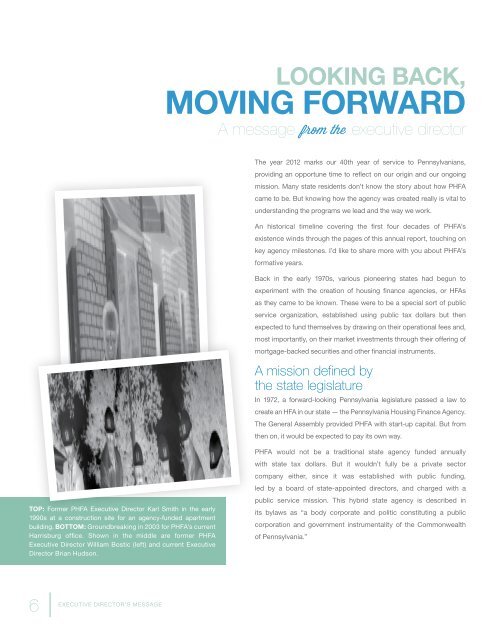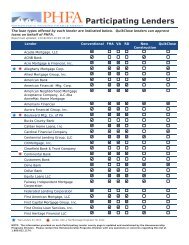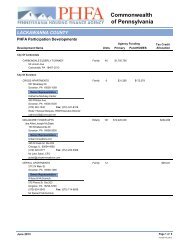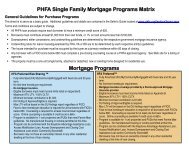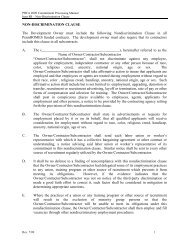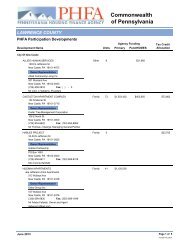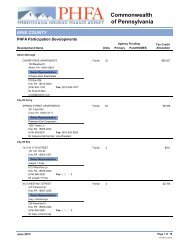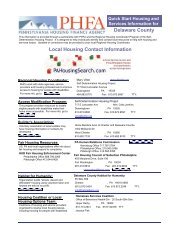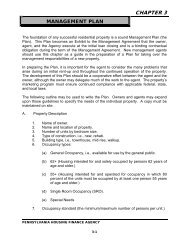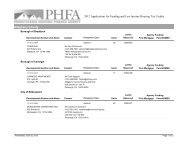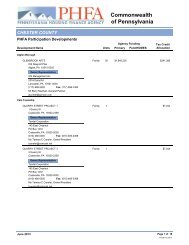2012 PHFA Annual Report - Pennsylvania Housing Finance Agency
2012 PHFA Annual Report - Pennsylvania Housing Finance Agency
2012 PHFA Annual Report - Pennsylvania Housing Finance Agency
Create successful ePaper yourself
Turn your PDF publications into a flip-book with our unique Google optimized e-Paper software.
looking back,<br />
moving forward<br />
A message from the executive director<br />
The year <strong>2012</strong> marks our 40th year of service to <strong>Pennsylvania</strong>ns,<br />
With an initial staff of eight, from its early office at 3211 North Front<br />
providing an opportune time to reflect on our origin and our ongoing<br />
Street in Harrisburg, <strong>PHFA</strong> was charged with ensuring that affordable<br />
mission. Many state residents don’t know the story about how <strong>PHFA</strong><br />
housing options would be available to the state’s residents, filling a void<br />
came to be. But knowing how the agency was created really is vital to<br />
not being fully addressed by the marketplace.<br />
understanding the programs we lead and the way we work.<br />
There was no model elsewhere for how this work was to be done. So<br />
An historical timeline covering the first four decades of <strong>PHFA</strong>’s<br />
the staff learned by doing. In some instances, HFAs in other states<br />
existence winds through the pages of this annual report, touching on<br />
tried new approaches, and we learned from their accomplishments. In<br />
key agency milestones. I’d like to share more with you about <strong>PHFA</strong>’s<br />
other cases, <strong>PHFA</strong> initiated novel programs, gaining experience from its<br />
formative years.<br />
successes and from projects that fell short.<br />
Top: Former <strong>PHFA</strong> Executive Director Karl Smith in the early<br />
1990s at a construction site for an agency-funded apartment<br />
building. Bottom: Groundbreaking in 2003 for <strong>PHFA</strong>’s current<br />
Harrisburg office. Shown in the middle are former <strong>PHFA</strong><br />
Executive Director William Bostic (left) and current Executive<br />
Director Brian Hudson.<br />
Back in the early 1970s, various pioneering states had begun to<br />
experiment with the creation of housing finance agencies, or HFAs<br />
as they came to be known. These were to be a special sort of public<br />
service organization, established using public tax dollars but then<br />
expected to fund themselves by drawing on their operational fees and,<br />
most importantly, on their market investments through their offering of<br />
mortgage-backed securities and other financial instruments.<br />
A mission defined by<br />
the state legislature<br />
In 1972, a forward-looking <strong>Pennsylvania</strong> legislature passed a law to<br />
create an HFA in our state — the <strong>Pennsylvania</strong> <strong>Housing</strong> <strong>Finance</strong> <strong>Agency</strong>.<br />
The General Assembly provided <strong>PHFA</strong> with start-up capital. But from<br />
then on, it would be expected to pay its own way.<br />
<strong>PHFA</strong> would not be a traditional state agency funded annually<br />
with state tax dollars. But it wouldn’t fully be a private sector<br />
company either, since it was established with public funding,<br />
led by a board of state-appointed directors, and charged with a<br />
public service mission. This hybrid state agency is described in<br />
its bylaws as “a body corporate and politic constituting a public<br />
corporation and government instrumentality of the Commonwealth<br />
of <strong>Pennsylvania</strong>.”<br />
Exploring ways to expand<br />
affordable housing options<br />
So the agency grew. First, it focused on the funding of apartment<br />
buildings that would offer rents to people with low and moderate<br />
incomes, seniors, and people with disabilities. Later, it launched into<br />
the provision of affordable mortgages for people who were ready for<br />
the responsibilities of homeownership.<br />
Foreclosure prevention, too, became part of the agency’s mission<br />
with the start, in the 1980s, of the Homeowners’ Emergency Mortgage<br />
Assistance Program (HEMAP) that grew to become a national model<br />
due to its success. Still later, the agency added the enhancement of nocost<br />
counseling to educate people interested in buying their first home.<br />
Fourteen years into its existence, the young agency faced an<br />
extremely difficult financial market. Its ability to sustain itself was<br />
in jeopardy. The legislature stepped up at that time with a loan of<br />
$61 million to help <strong>PHFA</strong> through those challenging years. That loan<br />
was later repaid — with $1 million in interest.<br />
Since that time, the agency has been able to survive and thrive on its<br />
own investments, and through partnerships with other state agencies<br />
on financing for special housing programs. It has continued to evolve<br />
to meet the needs of a changing housing environment and dynamic<br />
financial markets.<br />
Understanding the vision that led to our creation helps us stay true to<br />
our mission. That’s why, in this 40th anniversary year, we pause to look<br />
back at how we started and where we’ve been. But our main focus,<br />
as always, remains toward the future — moving forward — so that we<br />
can continue to meet the challenge we were given four decades ago:<br />
To expand affordable housing options for <strong>Pennsylvania</strong>ns. It’s that task<br />
that motivates us in our ongoing service to the state’s residents.<br />
We’re <strong>PHFA</strong>. Welcome home!<br />
Brian A. Hudson Sr.<br />
Executive Director and CEO<br />
ExECutive DIRECTor’s message<br />
annual report <strong>2012</strong><br />
6<br />
7


